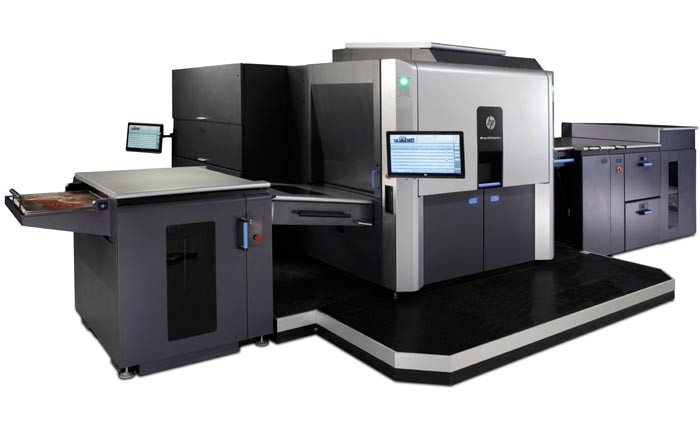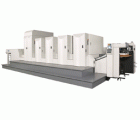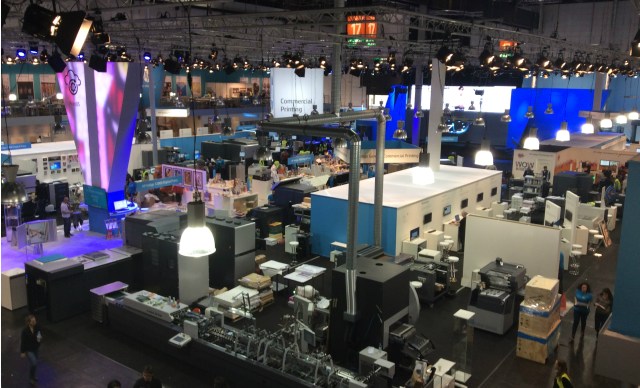
At its pre-Drupa event in Israel, the manufacturer announced its fourth-generation Indigo range, comprising two new sheetfed presses – the B2-format 10000 for commercial print and the 30000 for folding carton applications – along with the 20000, a continuous-feed machine for flexible packaging, whose printing frame is 73.6x110cm.
HP used the event to announce enhancements across its whole portfolio, claiming that every machine on the stand would be new since Drupa 2008.
The vendor had originally pointed to a larger-format Indigo as far back as 2000, but now launches the range into a market populated with B2 sheetfed inkjet machines from Fujifilm and Screen, with new B2 inkjet presses from Komori and KBA set to be unveiled at Drupa 2012.
The Indigo 10000 is a 75x53cm press that can reach speeds of 3,450 sheets per hour – note that HP is using the litho measurement rather than the traditional ‘pages per minute’, signalling its intention to attack the offset heartland head on.
The B2 format gives an image size that is 2.5 times larger than the existing Indigo maximum, and the machine offers a duty cycle of 2.2 million A4 pages per month.
The product team responsible for developing the fourth-generation range said more than 400 engineers had worked on presses over the past four years, and that the development of a large-size Indigo had presented a challenge as all the technology was completely new, with scaling up the laser scanning head a particular hurdle.
The machine will be on show at HP’s Drupa stand, along with the digital finishing systems especially designed by MBO and Horizon.
Beta sites for the 10000 are expected to commence at the end of this year with commercial shipments planned for 2013.
The next-gen presses will also offer HP’s ‘Enhanced Productivity Mode’ (EPM), a lower-cost running mode first revealed when it launched the WS6600 label press at Label Expo.
Essentially, EPM works by printing just three process colours – without black – to offer up to 33% higher productivity at a lower click charge.
However, despite only printing three of the four colours, it is more than 75% of the normal cost due the higher volumes of cyan, magenta and yellow inks.
As well as coming as standard on the next-gen presses, EPM will be field upgradeable across the existing third-generation Indigo range.
These existing Indigos have also been upgraded. The new flagship is the Indigo 7600, which can hit 160ppm in EPM mode – a 33% jump over the 7500’s top running speed of 120ppm. The Indigo 7500 is field upgradeable to EPM, as are the 5500 and 6500 devices.
Alon Bar-Shany, vice president and general manager of HP Indigo, conceded that the dramatic uplift in capacity of the B2 Indigos meant only certain printers would have the required volumes, adding that he expected the existing third-gen range to remain bestsellers.
“Quite frankly, this is not for everyone. These presses are large, they are very, very productive, and for a large part of the commercial printing industry, the 5600, the 6600 and the 7600 are going to be a better fit.”
Beyond the EPM mode, HP will roll out a whole swag of special features on the existing Indigos.
Users familiar with tricks found on rival machines such as the Canon C1, Fuji Xerox Color 1000 and Kodak Nexpress will recognise many of the new special features. For instance, the machines can be spec’d out with invisible security ink that fluoresces under UV light or run a textured ink to creates raised images.
A unique new process is “digital embossing”. The Indigo 7600 can create a “die” by doing up to 250 passes of the textured coating to build up a raised level, which is then used to emboss other sheets.
HP admitted that the emboss was not as deep or crisp as analogue process, but offered a quick and cheap alternative for short-run digital jobs.
Simon Lewis, director strategic marketing at Indigo, said: “It is not an embossing killer but it is a revolution in terms of being able to do it on-press.”
Comment below to have your say on this story.
If you have a news story or tip-off, get in touch at editorial@sprinter.com.au.
Sign up to the Sprinter newsletter


